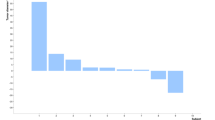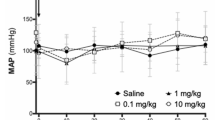Abstract
Angiogenesis plays a pivotal role in tumor growth, tissue invasion and metastasis. Endostatin is an angiogenesis inhibitor and has been shown to reduce tumor growth in animal models. However, therapy with recombinant endostatin protein was hampered by its short half-life and very-low yield of bioactive protein. We performed a phase I dose–escalation clinical trial using intratumoral injection of an adenovirus containing human endostatin gene (Ad-rhE; E10A; 1010–1012 virus particles (vp)) in 15 patients with advanced solid tumors. We observed intratumoral injections of E10A without dose-limiting toxicity. Most frequently reported E10A-related adverse events were transient fever and local response. Distribution studies revealed that the vector was detected in the blood, throat and injection site, but rarely in the urine and stool. An increased endostatin expression was detected using enzyme immunoassay in serum in 13 of 14 treated patients throughout the period of treatment despite the presence of neutralizing antiadenovirus antibody. Median serum basic fibroblast growth factor levels decreased from 32.4 pg ml−1 at baseline to 24.9 pg ml−1 after 28 days of first treatment. Thus, direct intratumoral injection of up to 1012 vp of E10A to patients is well tolerated and further studies are necessary to define and increase clinical efficacy.
This is a preview of subscription content, access via your institution
Access options
Subscribe to this journal
Receive 12 print issues and online access
$259.00 per year
only $21.58 per issue
Buy this article
- Purchase on Springer Link
- Instant access to full article PDF
Prices may be subject to local taxes which are calculated during checkout





Similar content being viewed by others
References
Bergers G, Benjamin LE . Tumorigenesis and the angiogenic switch. Nat Rev Cancer 2003; 3: 401–410.
Folkman J, Klagsbrun M . Angiogenic factors. Science 1987; 235: 442–447.
Folkman J, Weisz PB, Joullie MM, Li WW, Ewing WR . Control of angiogenesis with synthetic heparin substitutes. Science 1989; 243: 1490–1493.
Zeng Q, Li S, Chepeha DB, Giordano TJ, Li J, Zhang H et al. Crosstalk between tumor and endothelial cells promotes tumor angiogenesis by MAPK activation of Notch signaling. Cancer Cell 2005; 8: 13–23.
Boehm T, Folkman J, Browder T, O’Reilly MS . Antiangiogenic therapy of experimental cancer does not induce acquired drug resistance. Nature 1997; 390: 404–407.
Jain RK . Normalization of tumor vasculature: an emerging concept in antiangiogenic therapy. Science 2005; 307: 58–62.
Folkman J . Antiangiogenesis in cancer therapy—endostatin and its mechanisms of action. Exp Cell Res 2006; 312: 594–607.
Hurwitz H, Fehrenbacher L, Novotny W, Cartwright T, Hainsworth J, Heim W et al. Bevacizumab plus irinotecan, fluorouracil, and leucovorin for metastatic colorectal cancer. N Engl J Med 2004; 350: 2335–2342.
Eggert A, Ikegaki N, Kwiatkowski J, Zhao H, Brodeur GM, Himelstein BP . High-level expression of angiogenic factors is associated with advanced tumor stage in human neuroblastomas. Clin Cancer Res 2000; 6: 1900–1908.
Relf M, LeJeune S, Scott PA, Fox S, Smith K, Leek R et al. Expression of the angiogenic factors vascular endothelial cell growth factor, acidic and basic fibroblast growth factor, tumor growth factor beta-1, platelet-derived endothelial cell growth factor, placenta growth factor, and pleiotrophin in human primary breast cancer and its relation to angiogenesis. Cancer Res 1997; 57: 963–969.
O’Reilly MS, Boehm T, Shing Y, Fukai N, Vasios G, Lane WS et al. Endostatin: an endogenous inhibitor of angiogenesis and tumor growth. Cell 1997; 88: 277–285.
Dixelius J, Cross MJ, Matsumoto T, Claesson-Welsh L . Endostatin action and intracellular signaling: beta-catenin as a potential target? Cancer Lett 2003; 196: 1–12.
Abdollahi A, Hahnfeldt P, Maercker C, Grone HJ, Debus J, Ansorge W et al. Endostatin's antiangiogenic signaling network. Mol Cell 2004; 13: 649–663.
Li L, Liu RY, Huang JL, Liu QC, Li Y, Wu PH et al. Adenovirus-mediated intra-tumoral delivery of the human endostatin gene inhibits tumor growth in nasopharyngeal carcinoma. Int J Cancer 2006; 118: 2064–2071.
Liang ZH, Wu PH, Li L, Xue G, Zeng YX, Huang WL . Inhibition of tumor growth in xenografted nude mice with adenovirus-mediated endostatin gene comparison with recombinant endostatin protein. Chin Med J (Engl) 2004; 117: 1809–1814.
Wu Y, Yang L, Hu B, Liu JY, Su JM, Luo Y et al. Synergistic anti-tumor effect of recombinant human endostatin adenovirus combined with gemcitabine. Anticancer Drugs 2005; 16: 551–557.
Sauter BV, Martinet O, Zhang WJ, Mandeli J, Woo SL . Adenovirus-mediated gene transfer of endostatin in vivo results in high level of transgene expression and inhibition of tumor growth and metastases. Proc Natl Acad Sci USA 2000; 97: 4802–4807.
Capillo M, Mancuso P, Gobbi A, Monestiroli S, Pruneri G, Dell’Agnola C et al. Continuous infusion of endostatin inhibits differentiation, mobilization, and clonogenic potential of endothelial cell progenitors. Clin Cancer Res 2003; 9: 377–382.
Kisker O, Becker CM, Prox D, Fannon M, D’Amato R, Flynn E et al. Continuous administration of endostatin by intraperitoneally implanted osmotic pump improves the efficacy and potency of therapy in a mouse xenograft tumor model. Cancer Res 2001; 61: 7669–7674.
Herbst RS, Hess KR, Tran HT, Tseng JE, Mullani NA, Charnsangavej C et al. Phase I study of recombinant human endostatin in patients with advanced solid tumors. J Clin Oncol 2002; 20: 3792–3803.
Eder Jr JP, Supko JG, Clark JW, Puchalski TA, Garcia-Carbonero R, Ryan DP et al. Phase I clinical trial of recombinant human endostatin administered as a short intravenous infusion repeated daily. J Clin Oncol 2002; 20: 3772–3784.
Thomas JP, Arzoomanian RZ, Alberti D, Marnocha R, Lee F, Friedl A et al. Phase I pharmacokinetic and pharmacodynamic study of recombinant human endostatin in patients with advanced solid tumors. J Clin Oncol 2003; 21: 223–231.
Skovseth DK, Veuger MJ, Sorensen DR, De Angelis PM, Haraldsen G . Endostatin dramatically inhibits endothelial cell migration, vascular morphogenesis, and perivascular cell recruitment in vivo. Blood 2005; 105: 1044–1051.
Hansma AH, Broxterman HJ, van der Horst I, Yuana Y, Boven E, Giaccone G et al. Recombinant human endostatin administered as a 28-day continuous intravenous infusion, followed by daily subcutaneous injections: a phase I and pharmacokinetic study in patients with advanced cancer. Ann Oncol 2005; 16: 1695–1701.
He GA, Xue G, Xiao L, Wu JX, Xu BL, Huang JL et al. Dynamic distribution and expression in vivo of human endostatin gene delivered by adenoviral vector. Life Sci 2005; 77: 1331–1340.
Abdollahi A, Hlatky L, Huber PE . Endostatin: the logic of antiangiogenic therapy. Drug Resist Updat 2005; 8: 59–74.
Hoekstra R, de Vos FY, Eskens FA, Gietema JA, van der Gaast A, Groen HJ et al. Phase I safety, pharmacokinetic, and pharmacodynamic study of the thrombospondin-1-mimetic angiogenesis inhibitor ABT-510 in patients with advanced cancer. J Clin Oncol 2005; 23: 5188–5197.
Zhang YA, Nemunaitis J, Scanlon KJ, Tong AW . Anti-tumorigenic effect of a K-ras ribozyme against human lung cancer cell line heterotransplants in nude. Gene Therapy 2000; 7: 2041–2050.
Slos P, De Meyer M, Leroy P, Rousseau C, Acres B . Immunotherapy of established tumors in mice by intratumoral injection of an adenovirus vector harboring the human IL-2 cDNA: induction of CD8 (+) T-cell immunity and NK activity. Cancer Gene Ther 2001; 8: 321–332.
Acknowledgements
Supported by the National High Technology Research and Development Program of China, Grant no. 2006AA02Z489; the National Basic Research Program of China, Grant no.: 2004CB518801; the Research and Development Grand of Guangdong Province, Grant no.: 2003A10902; and The CMB-SUMS Scholar Program, Grant no.: 98-677.
Author information
Authors and Affiliations
Corresponding author
Rights and permissions
About this article
Cite this article
Li, HL., Li, S., Shao, JY. et al. Pharmacokinetic and pharmacodynamic study of intratumoral injection of an adenovirus encoding endostatin in patients with advanced tumors. Gene Ther 15, 247–256 (2008). https://doi.org/10.1038/sj.gt.3303038
Received:
Revised:
Accepted:
Published:
Issue Date:
DOI: https://doi.org/10.1038/sj.gt.3303038
Keywords
This article is cited by
-
Maximizing response to intratumoral immunotherapy in mice by tuning local retention
Nature Communications (2022)
-
Therapeutic gene editing: delivery and regulatory perspectives
Acta Pharmacologica Sinica (2017)
-
Translational oncology toward benefiting cancer patients: the Sun Yat-sen University Cancer Center experience
Science China Life Sciences (2016)
-
Multicenter Randomized Phase 2 Clinical Trial of a Recombinant Human Endostatin Adenovirus in Patients with Advanced Head and Neck Carcinoma
Molecular Therapy (2014)
-
Systemically administered liposome-encapsulated Ad-PEDF potentiates the anti-cancer effects in mouse lung metastasis melanoma
Journal of Translational Medicine (2013)



